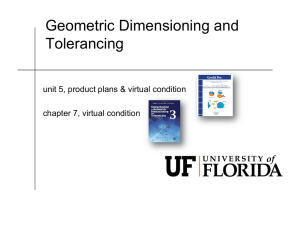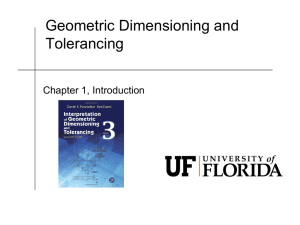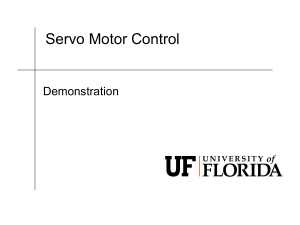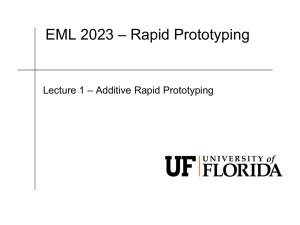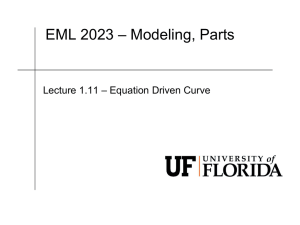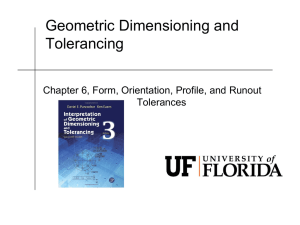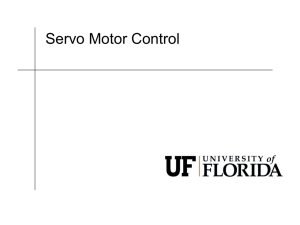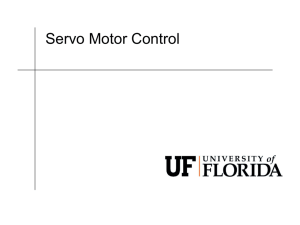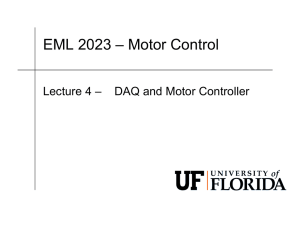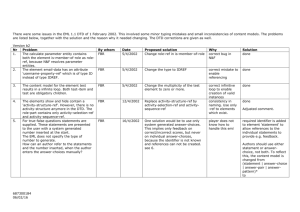Lecture2_fea
advertisement
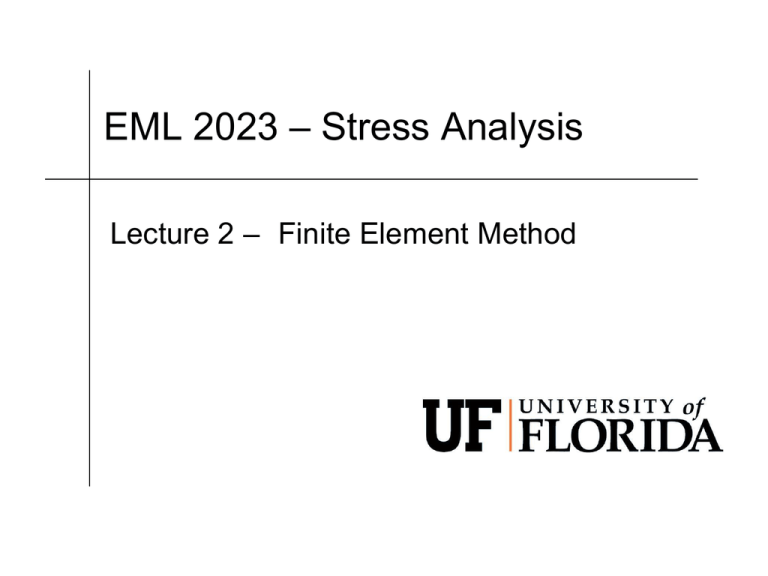
EML 2023 – Stress Analysis Lecture 2 – Finite Element Method Loading conditions axial loading torsion bending EML 2023 Department of Mechanical and Aerospace Engineering 2 Stress state the stress state at any point can be described by 6 values: three normal stresses and three shear stresses an orientation can be found such that there are no shear stresses the normal stresses are called the principal stresses EML 2023 Department of Mechanical and Aerospace Engineering 3 von Mises stress • Von Mises defined a single value for the stress state at a point based on the six stress values von m ises 1 x 2 y 2 2 2 2 2 2 x z y z 3 xy xz yz • in terms of the principal stresses von m ises 1 2 2 2 1 2 1 3 2 3 2 EML 2023 Department of Mechanical and Aerospace Engineering 4 von Mises stress • design objective – at every point, keep the von Mises stress below the yield stress of the material stress, force area strain , EML 2023 Department of Mechanical and Aerospace Engineering 5 The Finite Element Method • SolidWorks uses the Finite Element Method (FEM) to determine the vonMises stress at every point for a part under an applied loading condition. • Analysis using the FEM is called Finite Element Analysis (FEA) or Design Analysis. • Analytical solutions are only available for simple problems. They make many assumptions and fail to solve most practical problems. • FEA is very general. It can be used to solve simple and complex problems. • FEA is well-suited for computer implementation. It is universally recognized as the preferred method of analysis. EML 2023 Department of Mechanical and Aerospace Engineering 6 Main Concept of Design Analysis The FEM replaces a complex problem by many simple problems. It subdivides the model into many small pieces of simple shapes called elements. CAD Model CAD Model Subdivided into Small Pieces EML 2023 Department of Mechanical and Aerospace Engineering 7 Main Concept of Design Analysis • The elements share common points called nodes. The behavior of these elements is well-known under all possible support and load scenarios. N o d es Tetra he dr al E lem en t The motion of each node is fully described by translations in the X, Y, and Z directions. These are called degrees of freedom (DOF). Each node has 3 DOF. EML 2023 Department of Mechanical and Aerospace Engineering 8 Main Concept of Design Analysis • SolidWorks Simulation writes the equations governing the behavior of each element taking into consideration its connectivity to other elements. • These equations relate the unknowns, for example displacements in stress analysis, to known material properties, restraints, and loads. • Next, the program assembles the equations into a large set of simultaneous algebraic equations. There could be EML 2023 hundreds of thousands or evenDepartment millions of these equations. of Mechanical and Aerospace Engineering 9 Types of Analyses • • • • • • static nonlinear buckling frequency (vibrations) thermal optimization Fluid flow analysis is performed in a different module, i.e. SolidWorks Flow. EML 2023 Department of Mechanical and Aerospace Engineering 10 Types of Analysis: Static or Stress Analysis • This is the most common type of analysis. It assumes linear material behavior and neglects inertia forces. The body returns to its original position when loads are removed. • It calculates displacements, strains, stresses, and reaction forces. • A material fails when the stress reaches a certain level. Different materials fail at different stress levels. With static analysis, we can test the failure of many materials. EML 2023 Department of Mechanical and Aerospace Engineering 11 Types of Analysis: Nonlinear Static Analysis • Use nonlinear analysis, when at least one of the following conditions applies: a) The stress-strain relationship of the material is not linear. b) Induced displacements are large enough to change the stiffness. c) Boundary conditions vary during loading (as in problems with contact). Nonlinear analysis calculates stresses, displacements, strains, and reaction forces at all desired levels of loading. EML 2023 Department of Mechanical and Aerospace Engineering 12 Types of Analysis: Buckling Analysis • Slender models subjected to compressive axial loads tend to undergo sudden large lateral deformation. This phenomenon is called buckling. • Buckling could occur before the material fails due to high stresses. • Buckling analysis tests failure due to buckling and predicts critical loads. Axial Load This slender bar subjected to an axial load will fail due to buckling before the material starts to fail due to high stresses. EML 2023 Department of Mechanical and Aerospace Engineering 13 Types of Analysis: Frequency Analysis • Each body tends to vibrate at certain frequencies called natural frequencies. • For each natural frequency, the body takes a certain shape called a mode shape. Frequency analysis calculates the natural frequencies and associated mode shapes. In theory, a body has an infinite number of modes. In FEA, there are as many modes as DOF. In most cases, the first dominant modes are considered for the analysis. EML 2023 Department of Mechanical and Aerospace Engineering 14 Types of Analysis: Frequency Analysis • Excessive stresses occur if a body is subjected to a dynamic load vibrating at one of its natural frequencies. This phenomenon is called resonance. Frequency analysis can help you avoid resonance and solve dynamic response problems. EML 2023 Department of Mechanical and Aerospace Engineering 15 Types of Analysis: Thermal and Thermal Stress Analysis Thermal Analysis Calculates the temperature at every point in the model based on thermal loads and thermal boundary conditions. The results include thermal flux and thermal gradients. Thermal Stress Analysis Calculates stresses, strains, and displacements due to thermal effects and temperature changes. EML 2023 Department of Mechanical and Aerospace Engineering 16 Types of Analysis: Optimization Analysis Calculates the optimum solution to a problem based on the following: – Objective: Sets the goal of the analysis, like minimizing the material of the model. – Design variables: Specifies acceptable ranges for dimensions that can change. – Constraints: Sets the conditions that the optimum design should meet, like specifying a maximum value for stresses. EML 2023 Department of Mechanical and Aerospace Engineering 17 Analysis Steps 1. 2. 3. 4. Create a study to define the type of analysis. Define material for each component. Apply restraints and loads. Mesh the model. This is an automatic step in which the program subdivides the model into many small pieces. 5. Run the analysis. 6. View the results. – Steps 2, 3, and 4 can be done in any order. EML 2023 Department of Mechanical and Aerospace Engineering 18 Finite Element Analysis Process – Model part and specify material 6061 T6 aluminum 4” .25” EML 2023 Department of Mechanical and Aerospace Engineering 29 Specify fixtures. EML 2023 Department of Mechanical and Aerospace Engineering 30 Apply Loads 2000 N distributed across face EML 2023 Department of Mechanical and Aerospace Engineering 31 Create mesh EML 2023 Department of Mechanical and Aerospace Engineering 32 Run analysis EML 2023 Department of Mechanical and Aerospace Engineering 33
